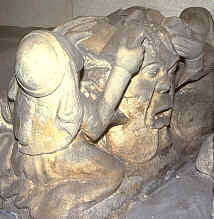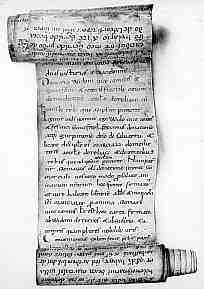


If you are looking at this page without frames, there is more information about medieval writing to be found by going to the home page (framed) or the site map (no frames).
| Forms of Manuscripts | |||
| Most manuscripts from the medieval period survive in one of three basic forms; the single sheet, the codex or the roll. The three forms tend to form different, although overlapping, functions. | |||
| Single sheets were used for many kinds of legal documents, such as charters, indentures or deeds. They were also used for personal letters |
 |
||
| A charter of 1372 in the form of a single sheet, from a private collection. | |||
 |
The codex is essentially a book; multiple double sided sheets bound between covers, as we have them today. The codex was the usual form for long works, such as Bibles and liturgical works, works of literature or works of scholarship. Institutions such as monasteries sometimes kept copies of their charters in the form of a codex called a cartulary. Documents originally issued in single sheet form could be bound together into codex form for safekeeping. Medieval libraries, like those of today, were largely collections of codices. | ||
| A praying figure at the foot of a tomb effigy in the parish church of Sprotborough, Yorkshire, reads from a codex. | |||
| The roll, in which single sheets of parchment were sewn together to form a long strip used in the middle ages. They were somewhat different in construction and organisation to the papyrus roll of antiquity. Although far less common than the codex, they were used for a diversity of purposes. |
 |
||
| An 11th century cartulary in the form of a roll, of the almshouse of Saint-Martial in Limoges. (Archives hospitalières de Limogers, A 2). From De Boüard 1929) | |||
| Large parchment sheets, or several sewn together, could be attached to a frame or wooden tablet to create what was known as a tabula. These were evidently used for various kinds of display purposes; for teaching in schools, for maps, religious diagrams or for library catalogues. Although there are some surviving examples, they are evidently known today more from written references and library catalogues. | |||
| Parchment being the expensive stuff it was, it wasn’t used for ephemeral purposes. Wax tablets set in small wooden frames and written on with a stylus, as used in Roman antiquity, were used in the middle ages by students, accountants and writers of private letters. | |||
|
If you are looking at this page without frames, there is more information about medieval writing to be found by going to the home page (framed) or the site map (no frames). |
|||